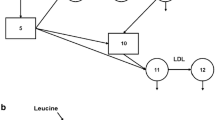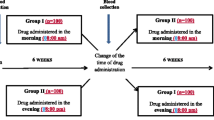Abstract
The objective of this study was to evaluate the kinetics of both free and esterified forms of cholesterol contained in a emulsion that binds to LDL receptors (LDE) in subjects with heterozygous familial hypercholesterolemia (FH), and the same subjects under the effects of high-dose simvastatin treatment, as compared with a control normolipidemic group (NL). Twentyone FH patients (44.0±13.0 yr, 12 females, LDL cholesterol levels 6.93±1.60 mmol/L) and 22 normolipidemic patients (44.0±15.0, 10 females, LDL cholesterol levels 3.15±0.62 mmol/L) were injected intravenously with 14C-cholesteryl ester and 3H-cholesterol. FH patients were also evaluated after 2 mon of 40 or 80 mg/d simvastatin treatment, and plasma samples were collected over 24 h to determine the residence time (RT, in h) of both LDE labels, expressed as the median (25%; 75%). The RT of both 14C-cholesteryl ester and 3H-cholesterol were greater in FH than in NL [FH: 36.0 (20.5; 1191.0), NL: 17.0 (12.0–62.5), P=0.015; and FH: 52.0 (30.0; 1515.0); NL 20.5 (14.0–30.0) P<0.0001]. Treatment reduced LDL cholesterol by 36% (P<0.0001), RT of 14C-cholesteryl ester by 49% (P=0.0029 vs. baseline), and 3H-cholesterol RT by 44% (P=0.019 vs. baseline). After treatment, the RT values of 14C-cholesteryl ester in the FH group approached the NL values (P=0.58), but the RT of 3H-cholesterol was still greater than those for the NL group (P=0.01). The removal of LDE cholesteryl esters and free cholesterol was delayed in FH patients. Treatment with a high dose of simvastatin normalized the removal of cholesterol esters but not the removal of free cholesterol.
Similar content being viewed by others
Abbreviations
- apo:
-
apolipoprotein
- CAD:
-
coronary artery disease
- FCR:
-
fractional catabolic rates
- FH:
-
familial hypercholesterolemia
- LDE:
-
cholesterol-rich emulsion
- NL:
-
normolipidemic
- PLTP:
-
phospholipid transfer proteins
- RT:
-
residence time
References
Ginsburg, G.S., Small, D.M., and Atkinson, D. (1982) Microemulsions of Phospholipids and Cholesterol Esters. Protein-free Models of Low Density Lipoprotein, J. Biol. Chem. 257, 8216–8227.
Maranhão, R.C., Cesar, T.B., Pedroso-Mariani, S.R., Hirata, M.H., and Mesquita, C.H. (1993) Metabolic Behavior in Rats of a Nonprotein Microemulsion Resembling Low Density Lipoprotein, Lipids 28, 691–696.
Maranhão, R.C., Garicochea, B., Silva, E.L., Dorlhiac-Llacer, P., Cadena, S.M., Coelho, I.J., Meneghetti, J.C., Pileggi, F.J., and Chamone, D.A. (1994) Plasma Kinetics and Biodistribution of a Lipid Emulsion Resembling Low-Density Lipoprotein in Patients with Acute Leukemia, Cancer Res. 54, 4660–4666.
Maranhão, R.C., Roland, I.A., Toffoletto, O., Ramires, J.A., Goncalves, R.P., Mesquita, C.H., and Pileggi, F. (1997) Plasma Kinetic Behavior in Hyperlipidemic Subjects of a Lipidic Microemulsion That Binds to Low Density Lipoprotein Receptors, Lipids 32, 627–633.
Hirata, R.D.C., Hirata, M.H., Mesquita, C.H., Cesar, T.B., and Maranhão, R.C. (1999) Effects of Apolipoprotein B-100 on the Metabolism of a Lipid Microemulsion Model in Rats, Biochim. Biophys. Acta 1437, 53–62.
Maranhão, R.C., Feres, M.C., Martins, M.T., Mesquita, C.H., Toffoletto, O., Vinagre, C.G., Gianinni, S.D., and Pileggi, F. (1996) Plasma Kinetics of a Chylomicron-like Emulsion in Patients with Coronary Artery Disease, Atherosclerosis 126, 15–25.
Borba, E.F., Bonfa, E., Vinagre, C.G., Ramires, J.A., and Maranhão, R.C. (2000) Chylomicron Metabolism Is Markedly Altered in Systemic Lupus Erythematosus, Arthritis Rheum. 43, 1033–1040.
Vinagre, C.G., Stolf, N.A., Bocchi, E., and Maranhão, R.C. (2000) Chylomicron Metabolism in Patients Submitted to Cardiac Transplantation, Transplantation 69, 532–537.
Santos, R.D., Sposito, A.C., Ventura, L.I., Cesar, L.A., Ramires, J.A., and Maranhão, R.C. (2000) Effect of Pravastatin on Plasma Removal of a Chylomicron-like Emulsion in Men with Coronary Artery Disease, Am. J. Cardiol. 85, 1163–1166.
Santos, R.D., Ventura, L.I., Sposito, A.C., Schreiber, R., Ramires, J.A., and Maranhão, R.C. (2001) The Effects of Gemfibrozil upon the Metabolism of Chylomicron-like Emulsions in Patients with Endogenous Hypertriglyceridemia, Cardiovasc. Res. 49, 456–465.
Mahley, R.W., and Innerarity, T.L. (1983) Lipoprotein Receptors and Cholesterol Homeostasis, Biochim. Biophys. Acta 737, 197–222.
Gaw, A., Packard, C.J., Lindsay, G.M., Murray, E.F., Griffin, B.A., Caslake, M.J., Colquhoun, I., Wheatley, D.J., Lorimer, A.R., and Shepherd, J. (1996) Effects of Colestipol Alone and in Combination with Simvastatin on Apolipoprotein B Metabolism, Arterioscl. Thromb. Vasc. Biol. 16, 236–249.
Vega, G.L., and Grundy, S.M. (1986) In vivo Evidence for Reduced Binding of Low Density Lipoproteins to Receptors as a Cause of Primary Moderate Hypercholesterolemia. J. Clin. Invest. 78, 1410–1414.
Santos, R.D., Hueb, W., Oliveira, A.A., Ramires, J.A., and Maranhão, R.C. (2003) Plasma Kinetics of a Cholesterol-rich Emulsion in Subjects With or Without Coronary Artery Disease, J. Lipid Res. 44, 464–469.
Schwartz, C.S., Zech, L.A., VandenBroek, J.M., and Cooper, P.S. (1993) Cholesterol Kinetics in Subjects with Bile Fistula, J. Clin. Invest. 91, 923–938.
Schwartz, C.S., VandenBroek, J.M., and Cooper, P.S. (2004) Lipoprotein Cholesteryl Ester Production, Transfer and Output in vivo in Humans, J. Lipid Res. 45, 1594–1607.
Austin, M.A., Hutter, C.M., Zimmern, R.L., and Humphries, S.E. (2004) Familial Hypercholesterolemia and Coronary Heart Disease: A HuGE Association Review, Am. J. Epidemiol. 160, 421–429.
Glomset, J.A., and Norum, K.R. (1973) The Metabolic Role of Lecithin: Cholesterol Acyltransferase: Perspectives from Pathology, Adv. Lipid Res. 11, 1–65.
The Scandinavian Simvastatin Survival Study Group (1994) Randomised Trial of Cholesterol Lowering in 4444 Patients with Coronary Heart Disease: The Scandinavian Simvastatin Survival Study (4S), Lancet 344, 1383–1389.
Civeira, F. (2004) International Panel on Management of Familial Hypercholesterolemia. Guidelines for the Diagnosis and Management of Heterozygous Familial Hypercholesterolemia, Atherosclerosis 173, 55–68.
Friedewald, W.T., Levy, R.I., and Fredrickson, D.D. (1972) Estimation of the Concentration of Low Density Lipoprotein Cholesterol in Plasma, Without Use of the Preparative Ultracentrifuge, Clin. Chem. 18, 499–502.
Folch, J., Lees, M., and Sloane Stanley, G.H. (1957) A Simple Method for the Isolation and Purification of Total Lipids from Animal Tissues, J. Biol. Chem. 226, 497–509.
Matthews, C.M.E. (1957) The Theory of Tracer Experiments with 131I-Labelled Plasma Proteins, Phys. Med. Biol. 2, 36–53.
Marchese, S.R.M., Mesquita, C.H., and Cunha, I.I.L. (1998) ANACOMP Program Application to Calculate 137Cs Transfer Rates in Marine Organisms and Dose in Man, J. Radioanal. Nucl. Chem. 232, 233–236.
Vélez-Carrasco, W., Lichtenstein, A.H., Barrett, P.H.R., Sun, Z., Dolnikowski, G.G., Welty, F.K., and Schaefer, E.J. (1999) Human Apolipoprotein A-I Kinetics Within Triglyceride-rich Lipoproteins and High Density Lipoproteins, J. Lipid Res. 40, 1695–1700.
International Commission on Radiological Protection (ICRP) (1979) Radiation Protection, in Part I. Limits for Intakes of Radionuclides by Workers (Sowby, F.S., ed.) ICRP Publication 30, pp. 1–73, Pergamon, Oxford, England.
Pinto, L.B., Wajngarten, M., Silva, E.L., Vinagre, C.C., and Maranhão, R.C. (2001) Plasma Kinetics of a Cholesterol-rich Emulsion in Young, Middle-Aged, and Elderly Subjects, Lipids 36, 1307–1311.
Ho, Y.K., Smith, R.G., Brown, M.S., and Goldstein, J.L. (1978) Low-Density Lipoprotein (LDL) Receptor Activity in Human Acute Myelogenous Leukemia Cells, Blood 52, 1099–1114.
Millar, J.S., Lichtenstein, A.H., Cuchel, M., Dolnikowski, G.G., Hachey, D.L., Cohn, J.S., and Schaefer, E.J. (1995) Impact of Age on the Metabolism of VLDL, IDL, and LDL Apolipoprotein B-100 in Men, J. Lipid Res. 36, 1155–1167.
Barret, P.H.R., and Watts, G.F. (2002) Shifting the LDL-Receptor Paradigm in Familial Hypercholesterolemia: Novel Insights from Recent Kinetic Studies of Apolipoprotein B-100 Metabolism, Atherosclerosis Suppl. 2, 1–4.
Gaffney, D., Forster, L., Caslake, M.J., Bedford, D., Stewart, J.P., Stewart, G., Wieringa, G., Dominiczak, M., Miller, J.P., and Packard, C.J. (2002) Comparison of Apolipoprotein B Metabolism in Familial Defective Apolipoprotein B and Heterogeneous Familial Hypercholesterolemia, Atherosclerosis 162, 33–43.
Yen, F.T., and Nishida, T. (1990) Rapid Labeling of Lipoproteins in Plasma with Radioactive Cholesterol. Application for Measurement of Plasma Cholesterol Esterification, J. Lipid Res. 31, 349–353.
Morton, R.E. (1999) Cholesteryl Ester Transfer Protein and Its Plasma Regulator: Lipid Transfer Inhibitor Protein, Curr. Opin. Lipidol. 10, 321–327.
Fielding, C.J., and Fielding, P.E. (1995) Molecular Physiology of Reverse Cholesterol Transport, J. Lipid Res. 36, 211–228.
Fielding, C.J. (1984) The Origin and Properties of Free Cholesterol Potential Gradients in Plasma, and Their Relation to Atherogenesis, J. Lipid Res. 25, 1624–1628.
Dobiasova, M., and Frohlich, J. (1998) Understanding the Mechanism of LCAT Reaction May Help to Explain the High Predictive Value of LDL/HDL Cholesterol Ratio, Physiol. Res. 47, 387–397.
Dobiasova, M., and Frohlich, J. (2001) The Plasma Parameter Log (TG/HDL-C) as an Atherogenic Index: Correlation with Lipoprotein Particle Size and Esterification Rate in apoB-Lipoprotein-Depleted Plasma (FER(HDL)), Clin. Biochem. 34, 583–588.
Rothblat, G.H., de la Llera-Moya, M., Atger, V., Kellner-Weibel, G., Williams, D.L., and Phillips, M.C. (1999) Cell Cholesterol Efflux: Integration of Old and New Observations Provides New Insights, J. Lipid, Res. 40, 781–796.
Rosenfeld, M.E., Chait, A., Bierman, E.L., King, W., Goodwin, P., Walden, C.E., and Ross, R. (1988) Lipid Composition of Aorta of Watanabe Heritable Hyperlipemic and Comparably Hypercholesterolemic Fat-Fed Rabbits. Plasma Lipid Composition Determines Aortic Lipid Composition of Hypercholesterolemic Rabbits, Arteriosclerosis 8, 338–347.
Bates, S.R., and Wissler, W. (1976) Effects of Hyperlipidemic Serum on Cholesterol Accumulation in Monkey Aortic Medial Cells, Biochim. Biophys. Acta 450, 78–88.
Tabas, I. (2002) Consequences of Cellular Cholesterol Accumulation: Basic Concepts and Physiological Implications, J. Clin. Invest. 110, 905–911.
Taskinen, S., Kovanen, P.T., Jarva, H., Meri, S., and Pentikainen, M.O. (2002) Binding of C-Reactive Protein to Modified Low-Density-Lipoprotein Particles: Identification of Cholesterol as a Novel Ligand for C-Reactive Protein, Biochem. J. 367, 403–412.
Morton, R.E. (1988) Free Cholesterol Is a Potent Regulator of Lipid Transfer Protein Function, J. Biol. Chem. 263, 12235–12241.
Kuksis, A., Myher, J.J., Geher, K., Jones, G.J., Breckenridge, W.C., Feather, T., Hewitt, D., and Little, J.A. (1982) Decreased Plasma Phosphatidylcholine/Free Cholesterol Ratio as an Indicator of Risk for Ischemic Vascular Disease, Arteriosclerosis 2, 296–302.
Fielding, C.J., Reaven, G.M., and Fielding, P.E. (1982) Human Noninsulin-Dependent Diabetes: Identification of a Defect in Plasma Cholesterol Transport Normalized in vivo by Insulin and in vitro by Selective Immunoadsorption of Apolipoprotein E, Proc. Natl. Acad. Sci. USA 79, 6365–6369.
Fielding, P.E., Fielding, C.J., Havel, R.J., Kane, J.P., and Tun, P. (1983) Cholesterol Net Transport, Esterification, and Transfer in Human Hyperlipidemic Plasma, J. Clin. Invest. 71, 449–460.
Melo, N.R., Latrilha, M.C., Santos, R.D., Pompei, L.M., and Maranhão, R.C. (2005) Effects in Post-menopausal Women of Transdermal Estrogen Associated with Progestin upon the Removal from the Plasma of a Microemulsion That Resembles Low-Density Lipoprotein (LDL), Maturitas 50, 275–281.
Aguilar Salinas, C.A., Barrett, H., and Schonfeld, G. (1998) Metabolic Modes of Action of the Statins in Hyperlipoproteinemias, Atherosclerosis 141, 203–207.
Bilheimer, D.W., Grundy, S.M., Brown, M.S., and Goldstein, J.L. (1983) Mevinolin and Colestipol Stimulate Receptor-Mediated Clearance of Low Density Lipoprotein from Plasma in Familial Hypercholesterolemia Heterozygotes, Proc. Natl. Acad. Sci. USA 80, 4124–4128.
Raal, F.J., Pilcher, G.J., Illingworth, D.R., Pappu, A.S., Stein, E.A., Laskarzewski, P., Mitchel, Y.B., and Melino, M.R. (1997) Expanded-Dose Simvastatin Is Effective in Homozygous Familial Hypercholesterolaemia, Atherosclerosis 135, 249–256.
Marais, A.D., Naoumova, R.P., Firth, J.C., Penny, C., Neuwirth, C.K., and Thompson, G.R. (1997) Decreased Production of Low Density Lipoprotein by Atorvastatin After Apheresis in Homozygous Familial Hypercholesterolemia, J. Lipid Res. 38, 2071–2078.
Homma, Y., Ozawa, H., Kobayashi, T., Yamaguchi, H., Sakane, H., and Nakamura, H.R. (1995) Effects of Simvastatin on Plasma Lipoprotein Subfractions, Cholesterol Esterification Rate, and Cholesteryl Ester Transfer Protein in Type II Hyperlipoproteinemia, Atherosclerosis 114, 223–234.
Author information
Authors and Affiliations
Corresponding author
About this article
Cite this article
Santos, R.D., Chacra, A.P.M., Morikawa, A. et al. Plasma kinetics of free and esterified cholesterol in familial hypercholesterolemia: Effects of simvastatin. Lipids 40, 737–743 (2005). https://doi.org/10.1007/s11745-005-1437-6
Received:
Accepted:
Issue Date:
DOI: https://doi.org/10.1007/s11745-005-1437-6




